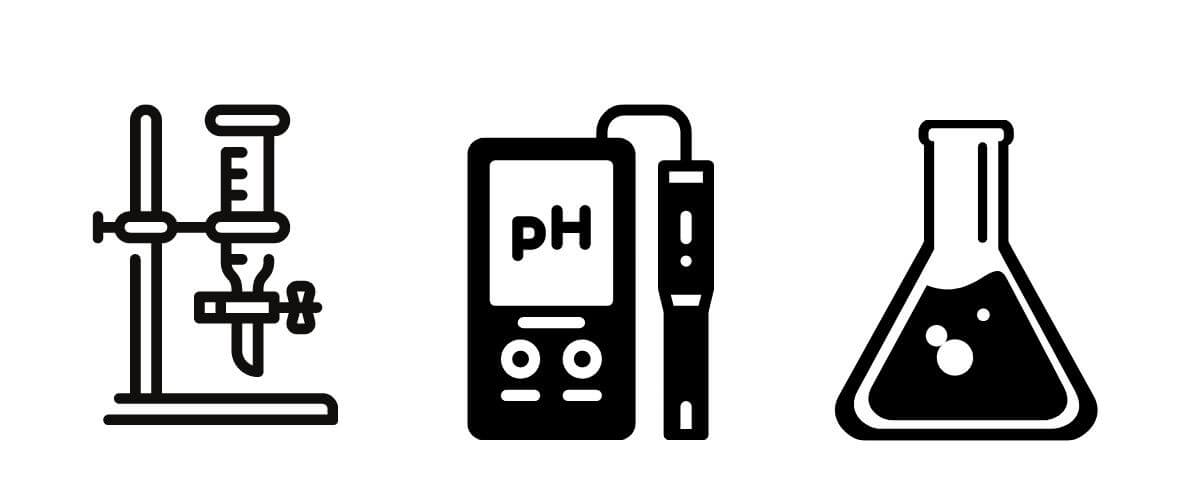
Inorganic chemistry labs require specialized equipment. Without this equipment, inorganic chemists cannot conduct experiments, observation, and research projects.
What Is Inorganic Chemistry?
Inorganic chemistry is the branch of chemistry that deals with inorganic, non-carbon-hydrogen bond-based molecules. Inorganic chemistry studies some substances that are familiar, like salts and metals, but also studies more unusual compounds and how all of these compounds react.
Inorganic chemistry labs play an important role in modern industry. They are used to study and develop reaction catalysts, polymers, fuels, surfactants, new materials, superconductors, highly technical ceramic components, and pharmaceuticals.
What Is Used In An Inorganic Chemistry Lab?
While no two labs are identical, there are many tools that are found in most inorganic chemistry labs.
Lab Basics: Storage Space
No matter what other equipment you have in an inorganic chemistry lab, you must have storage space for your small tools and chemical reagents. Inorganic chemistry often deals with chemical reagents that have strong reactions, are caustic, or are fragile and easily destabilized.
This calls for highly precise and carefully calculated safety standards. Inorganic chemistry labs are outfitted with secure organization and storage for these chemicals.
For many inorganic chemistry labs, custom stainless steel casework is the ideal storage solution for the bulk of what they need to store, along with fridges, freezers, and other climate-controlled storage space.
Lab Basics: Bench Space
Bench space refers to the countertops and tables that are used to perform lab tasks. These act as spaces for computer workstations, equipment workstations, observation spaces, and other uses.
In an inorganic chemistry lab, inert countertops like stainless steel or epoxy resin are ideal choices because they won’t react with any accidental spills.
Customizing your lab’s bench space is ideal because it lets you set up the best workflow for the space you have. Good workflow and sufficient space are vital to the operation of an inorganic chemistry lab– if the workspace is too crowded, you run the risk of spills.
Depending on the equipment your lab uses, lab designers may also use custom benchwork for machines like mass spectrometers or microscopes.
Atomic Absorption Spectrophotometer
Method of Operation: Chemicals and the products of the reaction are placed in this machine to analyze the way they react to radiation and light.
Purpose: An AAS detects elements through the application of characteristic wavelengths of electromagnetic radiation.
Beakers, Flasks, and Laboratory Glassware
Method of Operation: Beakers, flasks, and cylinders are used to hold and heat liquids. These may be capped or uncapped and come in a variety of shapes and sizes.
Purpose: Laboratory glassware is used to store liquids and perform reactions.
Biological Safety Cabinets
Method of operation: Biological Safety Cabinets (BSCs) work by providing an aseptic environment and containment for volatile chemicals. Inorganic chemistry laboratories can often use Class II BSCs as standard, but labs using more hazardous reagents may use Class III BSCs.
Purpose: BSCs protect laboratory workers and the surrounding environment from chemicals and the products of their reactions.
Buchner Funnel
Method of Operation: Buchner funnels allow you to filter liquids by pulling them through qualitative filter paper and perforations in the top of the funnel using a vacuum pump.
Purpose: Buchner Funnels are used in inorganic chemistry laboratories for the vacuum-assisted filtration and separation of liquid substances.
Burette (or Buret)
Method of Operation: Burettes are narrow tubes filled with liquid that have two valves which allow you to set a highly precise amount of liquid to flow through. Adjusting these valves changes the rate and volume of flow through the tube.
Purpose: Burettes are used in titration to measure precisely how much liquid has been delivered.
Centrifuge
Method of operation: A centrifuge uses a motor to spin liquid samples at high speed, moving the denser components to the outside of the test tube and allowing the solids to settle completely and rapidly at the bottom of the tube. Liquid can then be drained off, allowing a dry pellet to be analyzed.
Purpose: Centrifuges separate heterogeneous mixtures into their various components based on the different densities of the components. A centrifuge is needed for the removal of preservatives, experimental additives and other substances. Centrifuges also spin down and isolate solids produced by reactions.
Chromatography Equipment
Method of operation: Chromatography equipment is used to separate and purify the components of a mixture for later use. This equipment may be used for preparative or analytical techniques.
Purpose: Chromatography equipment allows the separation and the qualitative and quantitative analysis of complex mixtures and compounds.
Electron Microscopy Equipment
Method of Operation: Tiny quantities of material are coated with metallic alloys and then scanned with a laser in a vacuum chamber.
Purpose: Electron microscopy is used to determine particle size, shape, and texture.
Laminar Flow Hoods
Method of operation: Laminar flow hoods are used in a wide array of applications to keep airborne particles away from a workspace and lab operators. The air from a laminar flow hood goes back into the environment untreated so only non-hazardous materials should be handled in this type of work zone.
Purpose: Laminar flow cabinets provide airflow that helps keep the working environment free of contaminants. They prevent airborne contamination by providing uniform HEPA-filtered air flow across the work area.
Magnetometry Equipment
Method of Operation: Various types of magnetometers are used to measure metallic reactions to magnetic fields.
Purpose: Magnetometers measure the strength and direction of magnetic fields and determine the magnetization of materials.
Mass Spectrometer
Method of operation: Mass spectrometers sort and weigh ionized molecular fragments, a mass spectrometer can identify different molecular compounds based on their weight.
Purpose: Mass spectrometers are used to determine how chemicals change during a reaction and identify what products are created.
pH Meter
Method of operation: pH meters use electrodes to measure hydrogen ion activity in water-based solutions.
Purpose: pH meters measure the acidity or alkalinity of a solution.
Polarized Light Microscope
Method of operation: Polarized light microscopes allow you to see chemical structures like crystallization that cannot be seen under normal light conditions. The lenses of these microscopes make it possible to see how light is diffracted and reflected by chemical structures.
Purpose: Polarized light microscopes allow you to observe chemical structures which cannot be seen without magnification.
Separatory Funnel
Method of Operation: These conical funnels have valves at the bottom that selectively allow liquids through.
Purpose: These funnels are used to separate layers of immiscible liquids or for dropping liquids.
Vacuum Flask
Method of Operation: Using a Buchner funnel and vacuum line, vacuum flasks have the air pumped out of them, creating a pressure-free environment.
Purpose: Vacuum flasks are used either for filtering solutions or for removing the solvent under reduced pressure.
X-Ray Powder Diffraction Instrumentation
Method of Operation: X-Ray Powder Diffraction (XRD) is done by grinding solid material into a fine powder that is homogenized and analyzed with X-rays.
Purpose: XRD is used for the phase identification of crystalline material.
Need Help With Your Inorganic Chemistry Lab?
If you’re planning on building or renovating your inorganic chemistry lab and want to discuss custom casework and lab benches to meet the needs of your floor plan, OnePointe Solutions can help. Call us at (866) 612-7312 to speak to a lab design specialist today.


